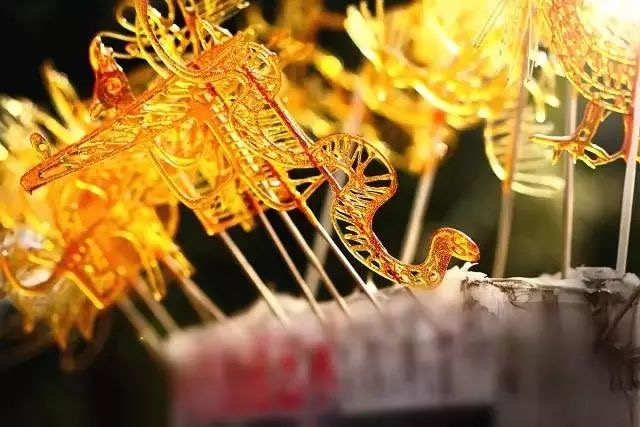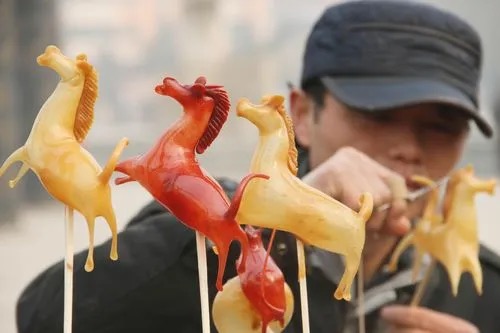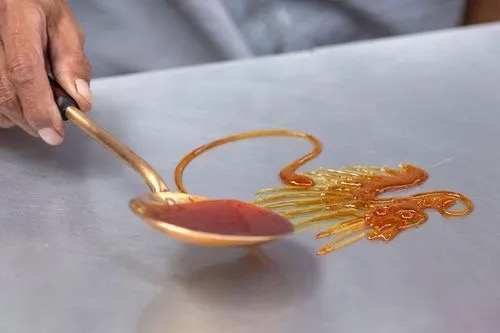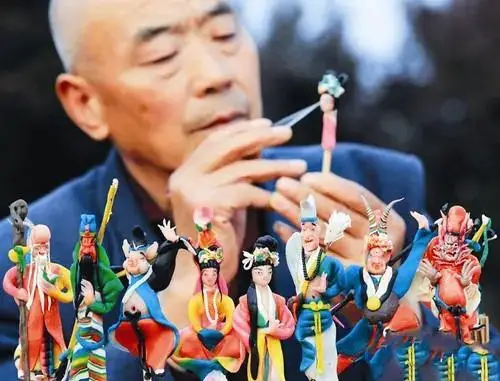Sugar figure crafting is a traditional Chinese handicraft. Crafters carry a frame, one end equipped with a heating stove, and the other end holding the sugar ingredients and tools. These ingredients, made from heating cane sugar and malt sugar, retain their natural brownish-yellow hue, although some artisans incorporate pigments or dyes to achieve red or green colors. The critical aspect of the process is controlling the heat: overheating causes the mixture to become too thin and prone to deformation, while cooling too much makes it too hard to shape. The tools used are simple, mainly spoon-shaped and shovel-shaped.
sugar figurines meaning
Sugar figure, also known as ‘sugar painting,’ ‘sugar sculpting,’ or ‘sugar figurine,’ is a folk traditional handicraft originating from the Tang Dynasty and flourishing during the Ming and Qing Dynasties, representing one of the treasures of Chinese traditional culture.
Crafted from melted cane sugar or malt sugar, sugar figures undergo a process involving heating, stirring, and simmering, achieving a malleable consistency. Artisans skillfully mold the sugar material into various shapes, including figures of people, animals, flowers, among others, showcasing vivid imagery and vibrant colors.

The creation of sugar figures demands a mastery of specific techniques and experience, involving control of heat, preparation of the sugar material, and skillful handling. Crafting these figures requires patience and meticulous attention to detail, ensuring each element is meticulously formed to produce a flawless piece.
Beyond being a traditional handicraft, sugar figures represent a cultural heritage and a testament to history. They embody the wisdom and creativity of the Chinese people, reflecting the diverse and rich cultural heritage of the Chinese nation.
In modern society, with the advancement of technology and changes in lifestyle, the artistry of crafting sugar figures has gradually faded. However, as appreciation for traditional culture grows and awareness of its preservation increases, sugar figures, as a traditional handicraft, have been revitalized, once again demonstrating their vitality and importance.
Chinese sugar figurines styles
The variety of sugar figures can be broadly categorized into the following types:
Blown Sugar Figures: This is the most common type of sugar figure. Crafters use air to blow molten sugar into various shapes, such as animals or figures. Blown sugar figures are lively, colorful, and greatly adored by children due to their engaging and vibrant appearances.

Painted Sugar Figures: These are created by outlining various patterns with sugar syrup on wooden boards. Crafters require specific painting skills to produce lifelike painted sugar figures. The designs on painted sugar figures vary widely, encompassing animals, human figures, flowers, among others, featuring vivid colors and possessing high artistic value.

Molded Sugar Figures: This type involves shaping molten sugar into diverse forms through kneading, molding, and other manual techniques. Crafters need adept manual skills to craft vivid molded sugar figures. These figures come in various shapes, including animals, human figures, featuring vibrant colors and high aesthetic appeal.

In addition to these three common types of sugar figures, there are other varieties such as carved sugar figures and molded sugar figures. Each type possesses unique characteristics but demands a certain level of crafting skills and experience to create perfect pieces.
sugar figurines history
Sugar figures have a long-standing history that dates back to the Tang Dynasty. During that time, the molten sugar used for making sugar figures emitted a fragrance. Thus, vendors selling blown sugar figures used “Xiangyin” as their distinctive call. However, during the Song Dynasty, when Zhao Kuangyin became the emperor, as “Yin” sounded similar to his title, it was considered inauspicious. Consequently, sugar figure vendors replaced their calls with the sound of beating small copper gongs. This tradition continued through generations, making the sound of the copper gong a symbol of this craft.
In the past, artisans often carried a round tray decorated with birds, animals, insects, or flowers while beating the copper gong along the streets. After receiving payment, children could spin the pointer on the tray, and wherever it landed, the artisan would create that particular figure, attracting the attention of kids. Sugar figures, molded from molten sugarcane or malt sugar, depicted various forms such as human figures, animals, flowers, mostly in two-dimensional shapes, resembling today’s sugar painting. They were called “Theatrical Candies” at that time and later referred to as Thick Sugar Gourds, Blown Sugar Ma Po Tofu, Sugar-Swung Sugar Candy, Sugar Idols, Sugar Officials, Sugar Pagodas, Sugar Turtles, and more.
The invention of sugar figures is attributed to Liu Bowen, a brilliant Ming Dynasty chancellor, marking over 600 years of history. Legend has it that while passing through a village, Liu Bowen noticed a child playing with mud, crafting various animals from it, attracting a crowd. Impressed, Liu Bowen thought the child had great talent and decided to teach the child how to make sugar figures. After a period of learning and practice, the child mastered the art of crafting sugar figures. From then on, the child became a master sugar figure crafter, passing down the craft to future generations.
how to make sugar figurines
The steps to make sugar figurines are as follows:
Prepare ingredients: Sugar, maltose, food coloring (optional), bamboo sticks or wooden sticks, pot, spoon or sugar painting brush, etc.
Heat the sugar mixture: Combine sugar and maltose, add a suitable amount of water, heat, and stir until the mixture becomes thin and the color turns amber.
Prepare tools: Choose a suitable spoon or sugar painting brush, insert bamboo sticks or wooden sticks into the sugar mixture for subsequent handling.
Draw the sugar figurine: Lay plastic wrap on a clean table to prevent the sugar mixture from sticking. Then, pour the sugar mixture onto the plastic wrap using a spoon or sugar painting brush to create the desired pattern or shape.
Complete the drawing: Once the sugar mixture cools and solidifies, remove the plastic wrap and take the sugar figurine off.
Decorate the sugar figurine: If needed, add food coloring or other decorations to make the sugar figurine more lively and cute.
Inspect and repair: Check for cracks or flaws in the sugar figurine; if necessary, repair them.
Store the sugar figurine: Place the finished sugar figurine in a dry place, avoiding direct sunlight and damp environments.
It’s important to pay attention to the temperature of the sugar mixture during the process to prevent overheating or cooling. Additionally, making sugar figurines requires skill and practice to create perfect pieces.
Overall, making sugar figurines demands patience, attention, and a certain level of expertise to produce vividly colored and lifelike creations. If interested, learning the techniques and methods of making sugar figurines can enrich your handicraft skills.
sugar figurines symbolism
Sugar figurines, as a traditional handicraft, hold rich symbolic meanings.
Firstly, they symbolize happiness and reunion, commonly used during festive occasions. This symbolism arises from their vibrant colors and lively shapes, bringing joy and pleasure, signifying family harmony and happiness.
Secondly, sugar figurines also symbolize diligence and creativity. Crafting sugar figurines demands considerable time and effort, symbolizing the diligence and creativity of the laboring people. This symbolism reflects admiration for hard work and creativity, honoring the laboring population.
Moreover, sugar figurines represent positive emotions and auspicious symbolism. Exquisitely crafted sugar figurines are used for gifting and bestowing blessings, symbolizing good wishes and auspiciousness. This symbolism embodies people’s aspirations for a better life and their care and blessings for family and friends.
In summary, sugar figurines encompass diverse symbolic meanings, embodying admiration for happiness, reunion, diligence, creativity, and the pursuit of a better life and positive emotions.
sugar figurines in festivals
Sugar figurines are commonly used as gifts or decorations in various festivals across China.
Chinese New Year: Chinese New Year, the most significant traditional festival, sees sugar figurines as sweet treats that add joyous vibes to the celebrations. During this period, you can spot various sugar figurine stalls in streets and alleys, where children eagerly purchase them, enhancing the festive atmosphere.
Lantern Festival: Following Chinese New Year, the Lantern Festival marks an essential occasion where sugar figurines are an indispensable part. People consume tangyuan (sweet glutinous rice balls) and also acquire sugar figurines as desserts or decorations during this festival.
Qingming Festival: The Qingming Festival is a traditional Chinese day for honoring ancestors and sweeping graves, showing respect and remembrance. During this festival, sugar figurines can also be used as offerings, bringing a sweet and warm atmosphere to the occasion.
Dragon Boat Festival: The Dragon Boat Festival, another traditional Chinese festival, involves activities like eating zongzi (sticky rice dumplings) and dragon boat races. During this festival, sugar figurines can be enjoyed as one of the festive treats, bringing sweetness and joy to people.
Conclusion
The modern definition of sugar figurines can be summarized as follows: using boiled sugar or maltose as raw materials, various shaped sugar confectioneries are crafted through heating, stirring, and boiling processes. Sugar figurines can serve as food, sweets, desserts, as well as decorations and gifts. Mastery of specific skills and experience is required to create vivid and brightly colored sugar figurines.
With the advancement of technology and shifts in lifestyle, the craft of making sugar figurines has gradually faded into obscurity. However, as awareness and appreciation for traditional culture have risen, this traditional craft has experienced a resurgence, showcasing renewed vigor and vitality. Sugar figurines have become a cultural symbol and heritage, widely applied in various cultural activities and artistic creations.
Simultaneously, as modern food processing techniques have evolved, sugar figurines have been gradually replaced by modern food industry practices. Nevertheless, in certain regions and cultures, the traditional craft of making sugar figurines is preserved, passed down, and developed. These traditional techniques not only possess aesthetic value but also encapsulate rich cultural connotations and historical information.
In conclusion, sugar figurines represent one of China’s traditional handicrafts, holding substantial cultural significance and historical value. In contemporary society, it is essential to cherish and uphold this intangible cultural heritage, allowing it to continue flourishing and shining in modern times.
Reference:
“Shenyang’s Li Family Sugar Figurines: A Century-Long Inheritance of ‘Sweet Memories,’ Bridging the Gap Between China and the World” – ChinaQiao Net, November 18, 2023, 16:50
“Surprised! Sugar Figurines Can Also Be Very Chinese!” – Cultural and Tourism Department of Hebei Province, January 25, 2022